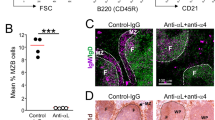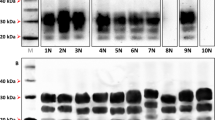Abstract
Although prion proteins are most efficiently propagated through intracerebral inoculation, peripheral administration has caused the diseases kuru, iatrogenic Creutzfeldt–Jakob disease (CJD), bovine spongiform encephalopathy (BSE) and new-variant CJD1,2. The development of neurological disease after peripheral inoculation depends on prion expansion within cells of the lymphoreticular system3,4. Here we investigate the identity of these cells by using a panel of immune-deficient mice inoculated with prions intraperitoneally: we found that defects affecting only T lymphocytes had no apparent effect, but that all mutations that disrupted the differentiation and response of B lymphocytes prevented the development of clinical scrapie. As an absence of B cells and of antibodies correlates with severe defects in follicular dendritic cells, a lack of any of these three components may prevent the development of clinical scrapie. However, we found that scrapie developed after peripheral inoculation in mice expressing immunoglobulins that were exclusively of the M subclass and without detectable specificity for the normal form of the prion PrPc, and in mice which had differentiated B cells but no functional follicular dendritic cells. We conclude that differentiated B cells are crucial for neuroinvasion by scrapie, regardless of the specificity of their receptors.
This is a preview of subscription content, access via your institution
Access options
Subscribe to this journal
Receive 51 print issues and online access
$199.00 per year
only $3.90 per issue
Buy this article
- Purchase on Springer Link
- Instant access to full article PDF
Prices may be subject to local taxes which are calculated during checkout


Similar content being viewed by others
References
Hill, A. F. et al.The same prion strain causes vCJD and BSE. Nature 389, 448–450 (1997).
Bruce, M. E. et al.Transmissions to mice indicate that ‘new variant’ CJD is caused by the BSE agent. Nature 389, 498–501 (1997).
Kitamoto, T., Muramoto, T., Mohri, S., Dohura, K. & Tateishi, J. Abnormal isoform of prion protein accumulates in follicular dendritic cells in mice with Creutzfeldt–Jakob disease. J. Virol. 65, 6292–6295 (1991).
Lasmezas, C. I. et al.Immune system-dependent and -independent replicaiton of the scrapie agent. J. Virol. 70, 1292–1295 (1996).
Shinkai, Y. et al.RAG-2-deficient mice lack mature lymphocytes owing to inability to initiate V(D)J rearrangement. Cell 68, 855–867 (1992).
Mombaerts, P. et al.RAG-1-deficient mice have no mature B and T lymphocytes. Cell 68, 869–877 (1992).
Huang, S. et al.Immune response in mice that lack the interferon-γ receptor. Science 259, 1742–1745 (1993).
Muller, U. et al.Functional role of type I and type II interferons in antiviral defense. Science 264, 1918–1921 (1994).
Rahemtulla, A. et al.Normal development and function of CD8+ cells but markedly decreased helper-cell activity in mice lacking CD4. Nature 353, 180–184 (1991).
Fung Leung, W. P. et al.CD8 is needed for development of cytotoxic T cells but not helper T cells. Cell 65, 443–449 (1991).
Zijlstra, M. et al.β2-Microglobulin-deficient mice lack CD4−8+ cytolytic T cells. Nature 344, 742–746 (1990).
Kägi, D. et al.Cytotoxicity mediated by T cells and natural killer cells is greatly impaired in perforin-deficient mice. Nature 369, 31–37 (1994).
Kitamura, D., Roes, J., Kuhn, R. & Rajewsky, K. AB-cell-deficient mouse by targeted disruption of the membrane exon of the immunoglobulin mu-chain gene. Nature 350, 423–426 (1991).
Fischer, M. et al.Prion protein (PrP) with amino-proximal deletions restoring susceptibility of PrP-knockout mice to scrapie. EMBO J. 15, 1255–1264 (1996).
Büeler, H. R. et al.Normal development and behaviour of mice lacking the neuronal cell-surface PrP protein. Nature 356, 577–582 (1992).
Büeler, H. R. et al.Mice devoid of PrP are resistant to scrapie. Cell 73, 1339–1347 (1993).
Fraser, H. et al.Replication of scrapie in spleens of scid mice follows reconstitution with wild-type mouse bone marrow. J. Gen. Virol. 77, 1935–1940 (1996).
Nonoyama, S., Smith, F. O., Bernstein, I. D. & Ochs, H. D. Strain-dependent leakiness of mice with severe combined immune deficiency. J. Immunol. 150, 3817–3824 (1993).
Bosma, M. J. & Carroll, A. M. The SCID mouse mutant: definition, characterization, and potential uses. Annu. Rev. Immunol. 9, 323–350 (1991).
Eigen, M. Prionics or the kinetic basis of prion diseases. Biophys. Chem. 63, A1–18 (1996).
Hill, A. F., Zeidler, M., Ironside, J. & Collinge, J. Diagnosis of new variant Creutzfeldt–Jakob disease by tonsil biopsy. Lancet 349, 99 (1997).
Rothe, J. et al.Mice lacking the tumour-necrosis factor receptor 1 are resistant to TNF-mediated toxicity but highly susceptibel to infection by Listeria monocytogenes. Nature 364, 798–802 (1993).
Le Hir, M. et al.Differentiation of follicular dendritic cells and full antibody responses require tumor necrosis factor receptor-1 signaling. J. Exp. Med. 183, 2367–2372 (1996).
Humphrey, J. H., Grennan, D. & Sundaram, V. The origin of follicular dendritic cells in the mouse and the mechanism of trapping of immune complexes on them. Eur. J. Immunol. 14, 859–864 (1984).
Blättler, T. et al.Transfer of scrapie infectivity from spleen to brain depends on interposed PrP-expressing tissue. Nature 389, 69–73 (1997).
Farquhar, C. F., Somerville, R. A. & Ritchie, L. A. Post-mortem immunodiagnosis of scrapie and bovine spongiform encephalopathy. J. Virol. Meth. 24, 215–221 (1989).
Kalinke, U. et al.The role of somatic mutation in the generation of the protective humoral immune response against vesicular stomatitis virus. Immunity 5, 639–652 (1996).
Prusiner, S. B. et al.Measurement of the scrapie agent using an incubation time interval assay. Ann. Neurol. 11, 353–358 (1982).
Brandner, S. et al.Normal host prion protein (PrPC) required for scrapie spread within the central nervous system. Proc. Natl Acad. Sci. USA 93, 13148–13151 (1996).
Acknowledgements
We thank C. Weissmann for discussion, and M. König, A. Burlet and N. Wey for technical help. M.K. is supported by a fellowship from the Deutsche Forschungsgemeinschaft. This work is supported by the Kanton of Zürich, the Bundesämter für Gesundheit, Veterinärwesen, Bildung und Wissenschaft, and by grants of the Swiss National Research Program to A.A., A.R. and R.Z.
Author information
Authors and Affiliations
Corresponding author
Rights and permissions
About this article
Cite this article
Klein, M., Frigg, R., Flechsig, E. et al. A crucial role for B cells in neuroinvasive scrapie. Nature 390, 687–690 (1997). https://doi.org/10.1038/37789
Received:
Accepted:
Published:
Issue Date:
DOI: https://doi.org/10.1038/37789
This article is cited by
-
Accelerated onset of CNS prion disease in mice co-infected with a gastrointestinal helminth pathogen during the preclinical phase
Scientific Reports (2020)
-
Effect of co-infection with a small intestine-restricted helminth pathogen on oral prion disease pathogenesis in mice
Scientific Reports (2019)
-
Unaltered intravenous prion disease pathogenesis in the temporary absence of marginal zone B cells
Scientific Reports (2019)
-
Prions, prionoids and protein misfolding disorders
Nature Reviews Genetics (2018)
-
Lymphocyte activation gene 3 (Lag3) expression is increased in prion infections but does not modify disease progression
Scientific Reports (2018)
Comments
By submitting a comment you agree to abide by our Terms and Community Guidelines. If you find something abusive or that does not comply with our terms or guidelines please flag it as inappropriate.



